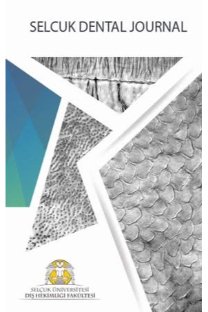An examination of the heat-conductive properties of temporary luting cements
Geçici yapıştırma simanlarının ısı iletim özelliklerinin incelenmesi
___
- 1. Lin M, Xu F, Lu TJ, Bai BF. review of heat transfer in human tooth-experimental characterization and mathematical modeling. Dent Mater 2010 ;26:501—13.
- 2. Moritz AR, Henriques FC. Studies of Thermal Injury: ll. The Relative Importance of time and Surface Tempera— ture in the Causation of Cutaneous Burns. Am Pathol 1947;23:695-720.
- Brown AC, Goldberg MP. Surface temperature and temperature gradients of human teeth in situ. Arch Oral Biol 1966;11:973— 82.
- Jafarzadeh H, (_ldoye Cl, Kinoshita J. The application of tooth temperature measurement in endodontic diagnosis: review. JEndod 2008;34:1435-40.
- Michalakis K, Pissiotis A, Hirayama H, Kang K, Kafantaris N. Comparison of temperature increase in the pulp chamber during the polymerization of materials used for the direct fabrication of provisional restorations. Prosthet Dent 2006 ;96:418-23.
- Seelbach P, Finger WJ, Ferger P, Balkenhol M. Temperature rise on dentin caused by temporary crown and fixed partial denture materials: influencing factors. JDent 2010 ;38z964-73.
- Malkoç S, Llysal T, (_lşümez S, lşman E, Baysal A. lnvitro assessment of temperature rise in the pulp during orthodontic bonding. Am Orthod Dentofacial Orthop 2010;137:379-83.
- Hussey DL, Biagioni PA, Lamey PJ. Thermographic measurement of temperature change during resin composite polymerization in vivo. JDent 1995;23:267-71.
- Kim SH, Watts DC. Exotherm behavior of the polymerbased provisional crown and fixed partial denture materials. Dent Mater 2004;20:383-7.
- Zach L, Cohen G. Pulp response to externally applied heat. Oral Surg Oral Med Oral Pathol 1965;19:515-30.
- Michailesco PM, Marciano J, Grieve AR, Abadie MJ. An in vivo recording of variations in oral temperature during meals: pilot study. JProsthet Dent 1995;73:214—8.
- Youngson CC, Barclay CW. pilot study of intraoral temperature changes. Clin Oral Inuestig 2000;4:183—9.
- Palmer DS, Barco MT, Billy EJ. Temperature extremes produced orally by hot and cold liquids. Prosthet Dent 1992;67:325—7.
- Barclay CW, Spence D, Laird WR. Intra-oral temperatures during function. Oral Rehabil 2005;32:886-94.
- Çengel A. Heat Transfer: Practical Approach. 2nd ed. New York: McGraw-Hill; 2003.
- Saatçi B, Maraşlı N, Gündüz M. Thermal conductivities of solid and liquid phases in Pb-Cd and Sn-Zn binary eutectic alloys. Thermo Acta 2007;454:128-234.
- Garrido PL, Hurtado Pl, Hadrowski B. Simple one-dimensional model of heat conduction which obeys Fourier’s law. Phys Rev Lett 2001 ;86:5486—9.
- Akbulut S, Ocak Y, Keşlioğlu K, Maraşlı N. Thermal conductivities of solid and liquid phases for neopentylglycol, aminomethylpropanediol and their binary alloy. Phys Chem Solids 2009;70: 72-8.
- Panas AJ, Zmuda S, Terpilowski J, Preiskorn M. Investigation of the thermal diffusity of human tooth hard tissue. [nt Thermophys 2003;24:837-47.
- Little PA, Wood DJ, Bubb NL, Maskill SA, Mair LH, Youngson CC. Thermal conductivity through various restorative lining materials. Dent 2005;33:585-91.
- Linsuwanont P, Versluis A, Palamara JE, Messer HH. Thermal stimulation causes tooth deformation: possible alternative to the hydrodynamic theory? Arch Oral Biol 2008;53:261—72.
- Brannstrom M. The hydrodynamic theory of dentinal pain: sensation in preparations, caries, and the dentinal crack syndrome. Ended 1986;12:453—7.
- Hashimoto M, [to S, Tay FR, Svizero NR, Sano H, Kaga M. Fluid movement across the resin-dentin interface during and after bonding. JDent Res 2004;83:843—8.
- Craig R. Restorative Dental Materials. 6th ed. Mosby. St. Louis, p: 443, 1980.
- Hume WR. Effect of eugenol on constrictor responses in blood vessels of the rabbit ear. JDent Res 1983;62:1013- 5.
- Schmalz G, Thonemann B. Zinc Oxide and Eugenol Cements. ln: Schmalz G, Arenholt-Bindslev (Ed). Biocompatibility of Dental Materials. SpringerSVerlag. Berlin, p:160-4, 2009.
- Murray PE, Hafez AA, Smith AJ, Cox CF. Hierarchy of pulp capping and repair activities responsible for dentin bridge formation. Am Dent 2002;15:236—43.
- Sweatman TL, Baumgartner JC, Sakaguchi RL. Radicular temperatures associated with thermoplasticized guttapercha. JEndod 2001;27:512-5.
- Braden M. Heat conduction in teeth and the effect of lining materials. Dent Res 1964;43:315-22.
- Little PA, Wood DJ, Bubb HL, Maskill SA, Mair LH, Young— son CC. Thermal conductivity through various restorative lining materials. Dent 2005;33:585-91.
- Becker RM, Hume WR, Wolinksy LE. Release of eugenol from mixtures of ZOE in vitro. Pedod 1983;8,:71—7.
- Fukase Y, Saitoh M, Kaketani M, Ohashi M, Nishiyama M. Thermal coefficients of paste-paste type pulp capping cements. Dent Mater 1992 ;11:189-96.
- ISSN: 1300-5170
- Yayın Aralığı: Yılda 3 Sayı
- Başlangıç: 1991
- Yayıncı: İsmail Marakoğlu
Sürmüş multiple kompound odontoma: Bir olgu sunumu
Sinan ERTEM, M. Kemal TÜMER, Nihat AKBULUT
Bilgisayar destekli görüntü analiziyle dental plak biyofilm miktarının belirlenmesi
EMİNE ELİF ALAADDİNOĞLU, BAHAR FÜSUN ODUNCUOĞLU
Aliye * KAMALAK, Hatice * ALÇİN, Ali * KELES
Ortodontite invisalign tekniği
MEHMET AKIN, Faruk Ayhan BAŞÇİFTÇİ
Sema BELLL, Hale ARI AYDINBELGE, Ali ERDEMLR, Ayşe ÜNVERDI ELDENİZ
Mehmet Burak GUNESER, Ayçe ELDENİZ ÜNVERDİ
Agresif ve kronik periodontitiste TNF-Ot ve lL-6 Gen polimorfizminin belirlenmesi
Ahu URAZ, Mehmet YALIM, MEHMET KEMAL TÜMER, Ayşenur PARLAK, Berceste GÜLER, Özge ŞİMŞEK
M. Kemal TÜMER, Sinan ERTEM, Nihat AKBLILUT, Kaan YERLLYURT
An examination of the heat-conductive properties of temporary luting cements
MERAL ARSLAN MALKOÇ, Ali KELEŞ, ŞENDOĞAN KARAGÖZ, Nilüfer Tülin POLAT
